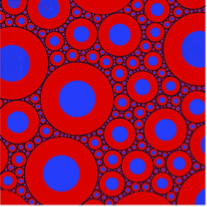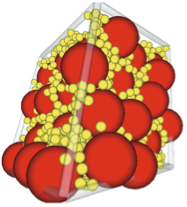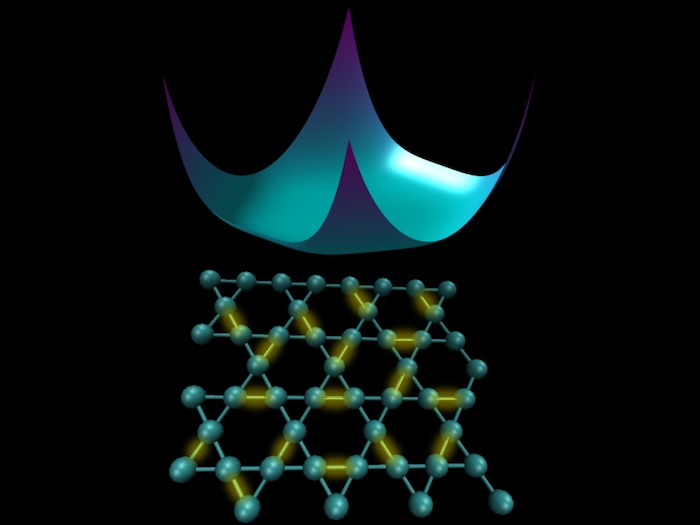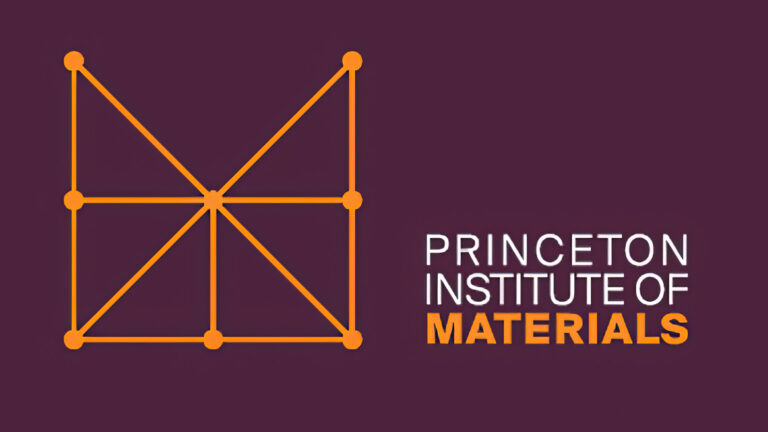

Salvatore Torquato
Contact:
Salvatore Torquato
Lewis Bernard Professor of Natural Sciences, Professor of Chemistry and the Princeton Institute for the Science and Technology of Materials (PRISM)
[email protected]
Frick Laboratory, 160
Phone: 609-258-3341
Faculty Assistant:
Julia Kazmierczak
Faculty / Grants Assistant
[email protected]
Frick Laboratory, 289
609-258-4883
Research Focus
Research work in the Torquato group is centered in statistical mechanics and soft condensed matter theory. Current topics of interest include unusual low-temperature states of matter, packing problems, inverse statistical mechanics, structure and bulk properties of colloids, liquids, glasses, quasicrystals and crystals, hyperuniformity, novel photonic materials, discrete geometry, self-assembly theory, disordered heterogeneous materials, optimization in materials science, and quantum mechanics.
Hyperuniformity

The multiscale “coated-cylinders” model, which is an example of a hyperuniform two-phase microstructure. Image from: J. Kim and S. Torquato, New Tessellation-Based Procedure to Design Perfectly Hyperuniform Disordered Dispersions for Materials Discovery, Acta Materialia, 168 143-151 (2019).
A hyperuniform many-particle system is characterized by an anomalous suppression of large-scale density fluctuations relative to those in typical disordered systems, such as liquids and structural glasses. The hyperuniformity concept generalizes the traditional notion of long-range order in many-particle systems to include all perfect crystals, perfect quasicrystals, and exotic amorphous states of matter. Disordered hyperuniform materials can have advantages over crystalline ones, such as nearly optimal, direction-independent physical properties and robustness against defects. The hyperuniformy concept has been extended to treat heterogeneous materials as well as scalar, vector and tensor fields. Currently, our group is interested in developing methodologies for efficiently constructing hyperuniform systems via simulation, as well as in the laboratory with our experimental collaborators. We are also keenly interested in characterizing and modelling the effective physical properties of disordered hyperuniform materials.
Some recent papers:
J. Kim and S. Torquato, Theoretical prediction of the effective dynamic dielectric constant of disordered hyperuniform anisotropic composites beyond the long-wavelength regime, Optical Materials Express, 14 194-215 (2024).
C. E. Maher, Y. Jiao, and S. Torquato, Hyperuniformity of maximally random jammed packings of hyperspheres across spatial dimensions, Physical Review E, 108 064602 (2023).
W. Shi, D. Keeney, D. Chen, Y. Jiao, and S. Torquato, Computational design of anisotropic stealthy hyperuniform composites with engineered directional scattering properties, Physical Review E, 108 045306 (2023).
P. K. Morse, J. Kim, P. J. Steinhardt, and S. Torquato, Generating large disordered stealthy hyperuniform systems with ultrahigh accuracy to determine their physical properties, Physical Review Research, 5 033190 (2023).
J. Kim and S. Torquato, Effective electromagnetic wave properties of disordered stealthy hyperuniform layered media beyond the quasistatic regime, Optica, 10 965-972 (2023).
M. Formanek, S. Torquato, R. Car, and F. Martelli, Molecular Rotations, Multiscale Order, Hyperuniformity, and Signatures of Metastability during the Compression/Decompression Cycles of Amorphous Ices, Journal of Physical Chemistry B, 127, 3946 (2023).
O. H. E. Philcox and S. Torquato, Disordered Heterogeneous Universe: Galaxy Distribution and Clustering across Length Scales, Physical Review X, 13 011038 (2023).
M. A. Klatt, P. J. Steinhardt, and S. Torquato, Wave propagation and band tails of two-dimensional disordered systems in the thermodynamic limit, Proceedings of the National Academy of Sciences, 119(52) e2213633119 (2022).
S. Torquato, Extraordinary disordered hyperuniform multifunctional composites, Journal of Composite Materials, 56(23), 3635-3649 (2022).
F. Sgrignuoli, S. Torquato, and L. Dal Negro, Subdiffusive wave transport and weak localization transition in three-dimensional stealthy hyperuniform disordered systems, Physical Review B, 105 064204 (2022).
M. A. Klatt, P. J. Steinhardt, and S. Torquato, Gap Sensitivity Reveals Universal Behaviors in Optimized Photonic Crystal and Disordered Networks, Physical Review Letters, 127 037401 (2021).
M. A. Klatt, P. J. Steinhardt, and S. Torquato, Gap Sensitivity Reveals Universal Behaviors in Optimized Photonic Crystal and Disordered Networks, Physical Review Letters, 127 037401 (2021).
S. Torquato, Structural characterization of many-particle systems on approach to hyperuniform states, Physical Review E, 103 052126 (2021).
S. Torquato, J. Kim, and M. A. Klatt, Local Number Fluctuations in Hyperuniform and Nonhyperuniform Systems: Higher-Order Moments and Distribution Functions, Physical Review X, 11, 021028 (2021).
S. Yu, C. W. Qiu, Y. Chong, S. Torquato, and N. Park, Engineered disorder in photonics, Nature Reviews Materials, 6 226 (2021).
J. Kim and S. Torquato, Characterizing the hyperuniformity of ordered and disordered two-phase media, Physical Review E, 103 012123 (2021).
Z. Ma, E. Lomba, and S. Torquato, Optimized Large Hyperuniform Binary Colloidal Suspensions in Two Dimensions, Physical Review Letters, 125 068002 (2020).
S. Torquato, Predicting Transport Characteristics of Hyperuniform Porous Media via Rigorous Microstructure-Property Relations, Advances in Water Resources, 140 103565 (2020).
M. M. Milošević, W. Man, G. Nahal, P. J. Steinhardt, S. Torquato, P. M. Chaikin, T. Amoah, B. Yu, R. A. Mullen, and M. Florescu, Hyperuniform Disordered Waveguides and Devices For Near Infrared Silicon Photonics, Scientific Reports, 9 20338 (2019).
J. Kim and S. Torquato, Methodology to Construct Large Realizations of Perfectly Hyperuniform Disordered Packings, Physical Review E, 99 052141 (2019).
S. Torquato, Hyperuniform States of Matter, Physics Reports, 745, 1-95 (2018).
Inverse Statistical Mechanics

A schematic illustrating the crux of inverse-statistical mechanics: relating the equilibrium structure of a many-particle configuration to the interparticle pair-potential. Image from: H. Wang, F. H. Stillinger and S. Torquato, Sensitivity of Pair Statistics on Pair Potentials in Many-Body Systems, The Journal of Chemical Physics, 153 124106 (2020).
The relationship between the collective structural behavior of many-body systems and their corresponding interactions is a fundamental subject in condensed-matter theory, chemistry and materials science. The “forward” approach of statistical mechanics focuses on finding the structure and macroscopic properties of many-particle systems with specified interactions. In “inverse” statistical mechanics, the goal is to find optimized interactions that robustly and spontaneously lead to a targeted many-particle configuration of the system for a wide range of conditions. The capacity to identify realizable configurations associated with targeted functional forms for pair statistics is an inverse problem of great fundamental and practical importance. Inverse statistical mechanics has been employed to design many-body systems that self-assemble into matter with unusual structures or properties, including low-coordinated crystals, porous colloidal mesophases and complex metal alloys.
Some recent papers:
H. Wang and S. Torquato, Equilibrium states corresponding to hyperuniform nonequilibrium pair statistics, Soft Matter, 19 550-564 (2023).
H. Wang, F. H. Stillinger, and S. Torquato, Realizability of iso-g2 processes via effective pair interactions, The Journal of Chemical Physics, 157 224106 (2022).
S. Torquato, and H. Wang, Precise determination of pair interactions from pair statistics of many-body systems in and out of equilibrium, Physical Review E, 106 044122 (2022).
H. Wang, and S. Torquato, Dynamic Measure of Hyperuniformity and Nonhyperuniformity in Heterogeneous Media via the Diffusion Spreadability, Physical Review Applied, 17 034022 (2022). (Editor’s Suggestion)
H. Wang, F. H. Stillinger and S. Torquato, Sensitivity of Pair Statistics on Pair Potentials in Many-Body Systems, The Journal of Chemical Physics, 153 124106 (2020).
G. Zhang and S. Torquato, Realizable Hyperuniform and Nonhyperuniform Particle Configurations with Targeted Spectral Functions via Effective Pair Interactions, Physical Review E, 101 032124 (2020).
Packing Problems

A maximally random jammed (MRJ) packing consisting of impenetrable spheres of two different sizes that has a relatively high packing efficiency. When realized as a metal powder, such dense bidisperse packings are well-suited for additive manufacturing applications.
The study of packings, i.e., collections of non-overlapping particles, is of fundamental importance to a broad set of fields including condensed matter physics, materials science, biology, and pure mathematics. Much of the recent work on packings in our group focuses on studying the generation and characterization of dense, maximally disordered, and structurally rigid packings called maximally random jammed (MRJ) packings. Such packings are known to be hyperuniform and thus are of particular interest to other research thrusts of our group as well as to the material science community at large. Some recent key results include demonstrating that a class of nonspherical 3D shapes called “superballs” are hyperuniform, demonstrating the ensuring structural rigidity in MRJ packings is intimately connected to the quality of their hyperuniformity, and showing that MRJ sphere packings become more strongly hyperuniform in higher spatial dimensions.
Some recent papers:
C. E. Maher, Y. Jiao, and S. Torquato, Hyperuniformity of maximally random jammed packings of hyperspheres across spatial dimensions, Physical Review E, 108 064602 (2023).
C. E. Maher, F. H. Stillinger, and S. Torquato, Characterization of void space, large-scale structure, and transport properties of maximally random jammed packings of superballs, Physical Review Materials, 6 025603 (2022).
C. E. Maher, F. H. Stillinger, and S. Torquato, Kinetic Frustration Effects on Dense Two-Dimensional Packings of Convex Particles and Their Structural Characteristics, Journal of Physical Chemistry B, 125, 2450 (2021).
G. Cinacchi and S. Torquato, Hard Convex Lens-Shaped Particles: Characterization of Dense Disordered Packings, Physical Review E, 100 062902 (2019).
S. Torquato, Perspective: Basic Understanding of Condensed Phases of Matter via Packing Models, The Journal of Chemical Physics, 149, 020901 (2018).
M.A. Klatt, and S. Torquato, Characterization of Maximally Random Jammed Sphere Packings. III. Transport and Electromagnetic Properties via Correlation Functions, Physical Review E, 97, 012118 (2018).
M. A. Klatt and S. Torquato, Characterization of Maximally Random Jammed Sphere Packings: II. Correlation Functions and Density Fluctuations, Physical Review E, 94, 022152 (2016).
M. A. Klatt and S. Torquato, Characterization of Maximally Random Jammed Sphere Packings: Voronoi Correlation Functions, Physical Review E, 90, 052120 (2014).
Heterogeneous Media and Multifunctional Materials

A multifunctional composite microstructure consisting of two different (green and yellow) materials. This particular microstructure can absorb sound waves while losslessly transmitting light. Image from: J. Kim and S. Torquato, Multifunctional Composites for Elastic and Electromagnetic Wave Propagation, Proceedings of the National Academy of Sciences of the United States of America, 117(16) 8764-8774 (2020).
Heterogeneous multiphase media and materials are ubiquitous in natural and synthetic situations. Examples of such materials include composites, porous media, foams, cellular solids, colloidal suspensions, granular media, polymer blends, vegetation patterns, geological media, and biological media. Our group is interested in developing computationally efficient heterogeneous microstructure (re)construction algorithms as well as simulation methods for characterizing microstructure geometry, topology, and effective physical (macroscopic) properties. We are also actively developing novel theories that rigorously relate microstructure to the effective (macroscopic) physical properties of the material. For example, our group has recently developed cross-property relations for two-phase composite media that link the effective elastic and electromagnetic wave characteristics to one another and thus facilitate multifunctional material design.
Some recent papers:
J. Kim and S. Torquato, Theoretical prediction of the effective dynamic dielectric constant of disordered hyperuniform anisotropic composites beyond the long-wavelength regime, Optical Materials Express, 14 194-215 (2024).
J. Kim and S. Torquato, Effective electromagnetic wave properties of disordered stealthy hyperuniform layered media beyond the quasistatic regime, Optica, 10 965-972 (2023).
M. Skolnick and S. Torquato, Simulated diffusion spreadability for characterizing the structure and transport properties of two-phase materials, Acta Materialia, 250 118857 (2023).
M. A. Klatt, P. J. Steinhardt, and S. Torquato, Wave propagation and band tails of two-dimensional disordered systems in the thermodynamic limit, Proceedings of the National Academy of Sciences, 119(52) e2213633119 (2022).
S. Torquato, Extraordinary disordered hyperuniform multifunctional composites, Journal of Composite Materials, 56(23), 3635-3649 (2022).
S. Torquato, M. Skolnick, and J. Kim, Local order metrics for two-phase media across length scales, Journal of Physics A: Mathematical and Theoretical, 55 274003 (2022).
S. Torquato, Diffusion spreadability as a probe of the microstructure of complex media across length scales, Physical Review E, 104 054102 (2021).
M. Skolnick, and S. Torquato, Understanding degeneracy of two-point correlation functions via Debye random media, Physical Review E, 104 045306 (2021).
M. A. Klatt, R. M. Ziff, and S. Torquato, Critical pore radius and transport properties of disordered hard- and overlapping-sphere models, Physical Review E, 104 014127 (2021).
M. A. Klatt, P. J. Steinhardt, and S. Torquato, Gap Sensitivity Reveals Universal Behaviors in Optimized Photonic Crystal and Disordered Networks, Physical Review Letters, 127 037401 (2021).
S. Torquato and J. Kim, Nonlocal Effective Electromagnetic Wave Characteristics of Composite Media: Beyond the Quasistatic Regime, Physical Review X, 11, 021002 (2021).
J. Kim and S. Torquato, Effective elastic wave characteristics of composite media, New Journal of Physics, 22 123050 (2020).
Z. Ma and S. Torquato, Generation and structural characterization of Debye random media, Physical Review E, 102 043310 (2020).
M. Röding, Z. Ma, and S. Torquato, Predicting Permeability via Statistical Learning on Higher-Order Microstructural Information, Scientific Reports, 10 15239 (2020).
J. Kim and S. Torquato, Multifunctional Composites for Elastic and Electromagnetic Wave Propagation, Proceedings of the National Academy of Sciences of the United States of America, 117(16) 8764-8774 (2020).
S. Torquato, Predicting Transport Characteristics of Hyperuniform Porous Media via Rigorous Microstructure-Property Relations, Advances in Water Resources, 140 103565 (2020).
Quantum Mechanics
Quantum ground states are disordered and hyperuniform as measured by pair statistics for both fermionic and bosonic systems. The deeper reasons for why such quantum systems are disordered and hyperuniform is an emerging topic of great interest in the group, including connections to quantum entanglement.
Some recent papers:
A. Bose and S. Torquato, Quantum phase transitions in long-range interacting hyperuniform spin chains in a transverse field, Physical Review B, 103 014118 (2021).
A. Scardicchio, C. E. Zachary and S. Torquato, Statistical Properties of Determinantal Point Processes in High-Dimensional Euclidean Spaces, Physical Review E, 79, 041108 (2009).
S. Torquato, A. Scardicchio and C. E. Zachary, Point Processes in Arbitrary Dimension from Fermionic Gases, Random Matrix Theory, and Number Theory, Journal of Statistical Mechanics: Theory and Experiment, P11019 (2008).
Honors
Member, Institute for Advanced Study (2021-2022)
Lewis Bernard Professor in Natural Sciences, Princeton University (2018)
American Chemical Society Joel Henry Hildebrand Award for Theoretical and Experimental Chemistry of Liquids (2017)
Simons Foundation Fellowship in Theoretical Physics (2012)
Fellow, Society for Industrial & Applied Mathematics (2009)
American Physical Society, David Adler Lectureship Award in Material Physics (2009)
Member, Institute for Advanced Study (2007 – 2008)
Society for Industrial & Applied Mathematics Ralph E. Kleinman Prize (2007)
Fellow, American Physical Society (2004)
Society of Engineering Science William Prager Medal (2004)
Member, Institute for Advanced Study (2003-2004)
Am. Soc. Mechanical Engineers Charles Russ Richards Memorial Award (2002)
Guggenheim Memorial Foundation Fellow (1998)
Member, Institute for Advanced Study (1998-1999)
Selected Publications
J. Kim and S. Torquato, Theoretical prediction of the effective dynamic dielectric constant of disordered hyperuniform anisotropic composites beyond the long-wavelength regime, Optical Materials Express, 14 194-215 (2024).
C. E. Maher, Y. Jiao, and S. Torquato, Hyperuniformity of maximally random jammed packings of hyperspheres across spatial dimensions, Physical Review E, 108 064602 (2023).
S. Torquato, Self-organized disordered vegetation patterns with hidden order in arid ecosystems, Proceedings of the National Academy of Sciences, 120(49) e2316879120 (2023).
W. Shi, D. Keeney, D. Chen, Y. Jiao, and S. Torquato, Computational design of anisotropic stealthy hyperuniform composites with engineered directional scattering properties, Physical Review E, 108 045306 (2023).
P. K. Morse, J. Kim, P. J. Steinhardt, and S. Torquato, Generating large disordered stealthy hyperuniform systems with ultrahigh accuracy to determine their physical properties, Physical Review Research, 5 033190 (2023).
J. Kim and S. Torquato, Effective electromagnetic wave properties of disordered stealthy hyperuniform layered media beyond the quasistatic regime, Optica, 10 965-972 (2023).
M. Formanek, S. Torquato, R. Car, and F. Martelli, Molecular Rotations, Multiscale Order, Hyperuniformity, and Signatures of Metastability during the Compression/Decompression Cycles of Amorphous Ices, Journal of Physical Chemistry B, 127, 3946 (2023).
M. Skolnick and S. Torquato, Simulated diffusion spreadability for characterizing the structure and transport properties of two-phase materials, Acta Materialia, 250 118857 (2023).
O. H. E. Philcox and S. Torquato, Disordered Heterogeneous Universe: Galaxy Distribution and Clustering across Length Scales, Physical Review X, 13 011038 (2023).
H. Wang and S. Torquato, Equilibrium states corresponding to hyperuniform nonequilibrium pair statistics, Soft Matter, 19 550-564 (2023).
M. A. Klatt, P. J. Steinhardt, and S. Torquato, Wave propagation and band tails of two-dimensional disordered systems in the thermodynamic limit, Proceedings of the National Academy of Sciences, 119(52) e2213633119 (2022).
H. Wang, F. H. Stillinger, and S. Torquato, Realizability of iso-g2 processes via effective pair interactions, The Journal of Chemical Physics, 157 224106 (2022).
S. Torquato, and H. Wang, Precise determination of pair interactions from pair statistics of many-body systems in and out of equilibrium, Physical Review E, 106 044122 (2022).
S. Torquato, and Y. Jiao, Exclusion volumes of convex bodies in high space dimensions: applications to virial coefficients and continuum percolation, Journal of Statistical Mechanics: Theory and Experiment, 2022 093404 (2022).
S. Torquato, Extraordinary disordered hyperuniform multifunctional composites, Journal of Composite Materials, 56(23), 3635-3649 (2022).
S. Torquato, M. Skolnick, and J. Kim, Local order metrics for two-phase media across length scales, Journal of Physics A: Mathematical and Theoretical, 55 274003 (2022).
H. Wang, and S. Torquato, Dynamic Measure of Hyperuniformity and Nonhyperuniformity in Heterogeneous Media via the Diffusion Spreadability, Physical Review Applied, 17 034022 (2022). (Editor’s Suggestion)
F. Sgrignuoli, S. Torquato, and L. Dal Negro, Subdiffusive wave transport and weak localization transition in three-dimensional stealthy hyperuniform disordered systems, Physical Review B, 105 064204 (2022).
C. E. Maher, F. H. Stillinger, and S. Torquato, Characterization of void space, large-scale structure, and transport properties of maximally random jammed packings of superballs, Physical Review Materials, 6 025603 (2022).
S. Torquato, Diffusion spreadability as a probe of the microstructure of complex media across length scales, Physical Review E, 104 054102 (2021).
M. Skolnick, and S. Torquato, Understanding degeneracy of two-point correlation functions via Debye random media, Physical Review E, 104 045306 (2021).
M. A. Klatt, R. M. Ziff, and S. Torquato, Critical pore radius and transport properties of disordered hard- and overlapping-sphere models, Physical Review E, 104 014127 (2021).
M. A. Klatt, P. J. Steinhardt, and S. Torquato, Gap Sensitivity Reveals Universal Behaviors in Optimized Photonic Crystal and Disordered Networks, Physical Review Letters, 127 037401 (2021).
S. Torquato, Swimming in circles can lead to exotic hyperuniform states of active living matter, Proceedings of the National Academy of Sciences, 118(24) e2107276118 (2021).
T. E. Gartner III, S. Torquato, R. Car, and P. G. Debenedetti, Manifestations of metastable criticality in the long-range structure of model water glasses, Nature Communications, 12 3398 (2021).
S. Torquato, Structural characterization of many-particle systems on approach to hyperuniform states, Physical Review E, 103 052126 (2021).
S. Torquato, J. Kim, and M. A. Klatt, Local Number Fluctuations in Hyperuniform and Nonhyperuniform Systems: Higher-Order Moments and Distribution Functions, Physical Review X, 11, 021028 (2021).
S. Torquato and J. Kim, Nonlocal Effective Electromagnetic Wave Characteristics of Composite Media: Beyond the Quasistatic Regime, Physical Review X, 11, 021002 (2021).
C. E. Maher, F. H. Stillinger, and S. Torquato, Kinetic Frustration Effects on Dense Two-Dimensional Packings of Convex Particles and Their Structural Characteristics, Journal of Physical Chemistry B, 125, 2450 (2021).
S. Yu, C. W. Qiu, Y. Chong, S. Torquato, and N. Park, Engineered disorder in photonics, Nature Reviews Materials, 6 226 (2021).
A. Bose and S. Torquato, Quantum phase transitions in long-range interacting hyperuniform spin chains in a transverse field, Physical Review B, 103 014118 (2021).
J. Kim and S. Torquato, Characterizing the hyperuniformity of ordered and disordered two-phase media, Physical Review E, 103 012123 (2021).
J. Kim and S. Torquato, Effective elastic wave characteristics of composite media, New Journal of Physics, 22 123050 (2020).
T. M. Middlemas and S. Torquato, Nearest-neighbor functions for disordered stealthy hyperuniform many-particle systems, Journal of Statistical Mechanics: Theory and Experiment, 2020 103302 (2020).
Z. Ma and S. Torquato, Generation and structural characterization of Debye random media, Physical Review E, 102 043310 (2020).
H. Wang, F. H. Stillinger and S. Torquato, Sensitivity of Pair Statistics on Pair Potentials in Many-Body Systems, The Journal of Chemical Physics, 153 124106 (2020).
M. Röding, Z. Ma, and S. Torquato, Predicting Permeability via Statistical Learning on Higher-Order Microstructural Information, Scientific Reports, 10 15239 (2020).
Z. Ma, E. Lomba, and S. Torquato, Optimized Large Hyperuniform Binary Colloidal Suspensions in Two Dimensions, Physical Review Letters, 125 068002 (2020).
E. Lomba, J.-J. Weis, L. Guisández, and S. Torquato, Minimal Statistical-Mechanical Model for Multihyperuniform Patterns in Avian Retina, Physical Review E, 102 012134 (2020).
J. Kim and S. Torquato, Multifunctional Composites for Elastic and Electromagnetic Wave Propagation, Proceedings of the National Academy of Sciences of the United States of America, 117(16) 8764-8774 (2020).
S. Torquato, Predicting Transport Characteristics of Hyperuniform Porous Media via Rigorous Microstructure-Property Relations, Advances in Water Resources, 140 103565 (2020).
G. Zhang and S. Torquato, Realizable Hyperuniform and Nonhyperuniform Particle Configurations with Targeted Spectral Functions via Effective Pair Interactions, Physical Review E, 101 032124 (2020).
M. A. Klatt, J. Kim, and S. Torquato, Cloaking the Underlying Long-Range Order of Randomly Perturbed Lattices, Physical Review E, 101 032118 (2020).
M. M. Milošević, W. Man, G. Nahal, P. J. Steinhardt, S. Torquato, P. M. Chaikin, T. Amoah, B. Yu, R. A. Mullen, and M. Florescu, Hyperuniform Disordered Waveguides and Devices For Near Infrared Silicon Photonics, Scientific Reports, 9 20338 (2019).
G. Cinacchi and S. Torquato, Hard Convex Lens-Shaped Particles: Characterization of Dense Disordered Packings, Physical Review E, 100 062902 (2019).
F. H. Stillinger and S. Torquato, Jammed Hard-Sphere Hcp Crystals Permeated With Trivacancy Tunnels, Journal of Applied Physics, 126(47) 194901 (2019).
M. A. Klatt, P. J. Steinhardt, and S. Torquato, Phoamtonic Designs Yield Sizeable 3D Photonic Band Gaps, Proceedings of the National Academy of Sciences, 116(47) 23480-23486 (2019).
S. Dutta, N. J.-V. Djabrayan, S. Torquato, S. Y. Shvartsman, and M. Krajnc, Self-Similar Dynamics of Nuclear Packing in the Early Drosophila Embryo, Biophysical Journal, 117(4) 743 (2019).
A. G. Meyra, G. J. Zarragoicoechea, A. L. Maltz, E. Lomba, and S. Torquato, Hyperunformity on Spherical Surfaces, Physical Review E, 100 022107 (2019).
F. H. Stillinger and S. Torquato, Structural Degeneracy in Pair Distance Distributions, The Journal of Chemical Physics, 150 204125 (2019).
J. Kim and S. Torquato, Methodology to Construct Large Realizations of Perfectly Hyperuniform Disordered Packings, Physical Review E, 99 052141 (2019).
S. Torquato, G. Zhang, and M. de Courcy-Ireland, Hidden Multiscale Order in the Primes, Journal of Physics A: Mathematical and Theoretical, 52 135002 (2019).
J. Kim and S. Torquato, New Tessellation-Based Procedure to Design Perfectly Hyperuniform Disordered Dispersions for Materials Discovery, Acta Materialia, 168 143-151 (2019).
M. A. Klatt, J. Lovrić, D. Chen, S. C. Kapfer, F. M. Schaller, P. W. A. Schönhöfer, B. S. Gardiner, A.-S. Smith, G. E. Schröder-Turk, and S. Torquato, Universal Hidden Order in Amorphous Cellular Geometries, Nature Communications, 10 811 (2019).
T. M. Middlemas, F. H. Stillinger, and S. Torquato, Hyperuniformity Order Metric of Barlow Packings, Physical Review E, 99 022111 (2019).
Z. Ma and S. Torquato, Hyperuniformity of Generalized Random Organization Models, Physical Review E, 99 022115 (2019).
E. C. Oğuz, J. E. S. Socolar, P. J. Steinhardt, and S. Torquato, Hyperuniformity and Anti-Hyperuniformity in One-Dimensional Substitution Tilings, Acta Crystallographica, A75 3-13 (2018).
J. Kim, G. Zhang, F. H. Stillinger, and S. Torquato, Inversion Problems for Fourier Transforms of Particle Distributions, Journal of Statistical Mechanics: Theory and Experiment, 2018 113302 (2018).
G. Cinacchi and S. Torquato, Hard Convex Lens-shaped Particles: Metastable, Glassy and Jammed States, Soft Matter, 14 8205-8218 (2018).
S. Torquato and D. Chen, Multifunctionality of Particulate Composites via Cross-property Maps, Physical Review Materials, 2 095603 (2018).
D. Chen, G. Zhang, and S. Torquato, Inverse Design of Colloidal Crystals via Optimized Patchy Interactions, Journal of Physical Chemsity B, 122 8462−8468 (2018).
S. Torquato, G. Zhang, and M. de Courcy-Ireland, Uncovering Multiscale Order in the Prime Numbers via Scattering, Journal of Statistical Mechanics: Theory and Experiment, 2018 093401 (2018).
S. Torquato and D. Chen, Multifunctional Hyperuniform Cellular Networks: Optimality, Anisotropy and Disorder, Multifunctional Materials, 1 015001 (2018).
Z. Ma and S. Torquato Precise Algorithms to Compute Surface Correlation Functions of Two-phase Heterogeneous Media and Their Applications, Physical Review E, 98, 013307 (2018).
S. Torquato, Perspective: Basic Understanding of Condensed Phases of Matter via Packing Models, The Journal of Chemical Physics, 149, 020901 (2018).
D. Chen, E. Lomba and S. Torquato, Binary Mixtures of Charged Colloids: a Potential Route to Synthesize Disordered Hyperuniform Materials, Physical Chemistry Chemical Physics, 20, 17557-17562 (2018).
F. Martelli, N. Giovambattista, S. Torquato, and R. Car, Searching for Crystal-ice Domains in Amorphous Ices, Physical Review Materials, 2, 075601 (2018).
S. Torquato, Hyperuniform States of Matter, Physics Reports, 745, 1-95 (2018).
C. Lin, P.J. Steinhardt, and S. Torquato, Light Localization in Local Isomorphism Classes of Quasicrystals, Physical Review Letters, 120, 247401 (2018).
R.A. DiStasio Jr., G. Zhang, F.H. Stillinger, and S. Torquato, Rational Design of Stealthy Hyperuniform Two-phase Media with Tunable Order, Physical Review E, 97, 023311 (2018).
G. Zhang, F. Martelli and S. Torquato, The Structure Factor of Primes, Journal of Physics A: Mathematical and Theoretical, 51, 115001 (2018).
J. Kim, and S. Torquato, Effect of Imperfections on the Hyperuniformity of Many-Body Systems, Physical Review B, 97, 054105 (2018).
M.A. Klatt, and S. Torquato, Characterization of Maximally Random Jammed Sphere Packings. III. Transport and Electromagnetic Properties via Correlation Functions, Physical Review E, 97, 012118 (2018).
E. Lomba, J.-J. Weis, and S. Torquato, Disordered Multihyperuniformity Derived from Binary Plasmas, Physical Review E, 97, 010102(R) (2018).
D. Chen and S. Torquato, Designing Disordered Hyperuniform Two-phase Materials with Novel Physical Properties, Acta Materialia, 142, 152-161 (2018).
Related News

Torquato quantifies disordered hyperuniformity in quantum spin liquids

Torquato Inducted into new DC-based Academy


